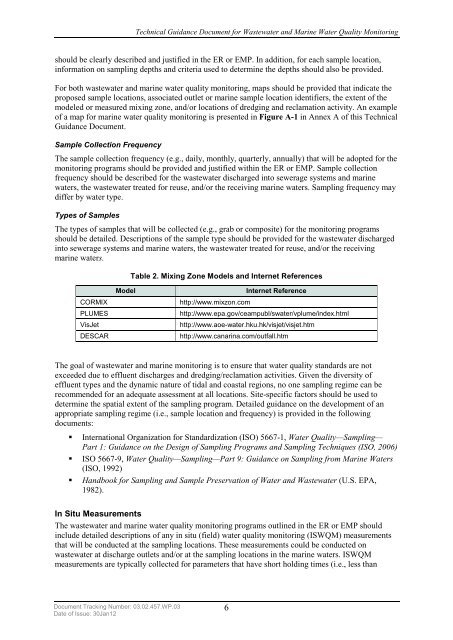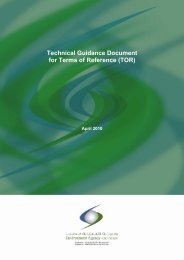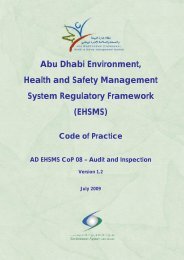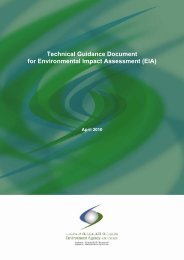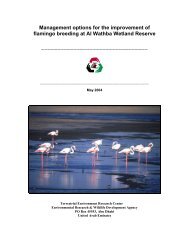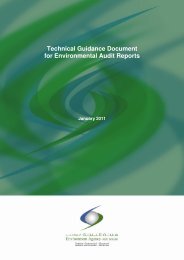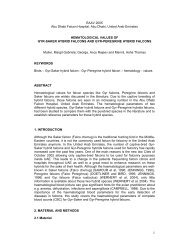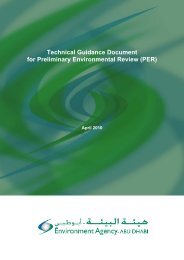<strong>Technical</strong> <strong>Guidance</strong> <strong>Document</strong> <strong>for</strong> <strong>Wastewater</strong> <strong>and</strong> <strong>Marine</strong> <strong>Water</strong> Quality Monitoringshould be clearly described <strong>and</strong> justified in the ER or EMP. In addition, <strong>for</strong> each sample location,in<strong>for</strong>mation on sampling depths <strong>and</strong> criteria used to determine the depths should also be provided.For both wastewater <strong>and</strong> marine water quality monitoring, maps should be provided that indicate theproposed sample locations, associated outlet or marine sample location identifiers, the extent of themodeled or measured mixing zone, <strong>and</strong>/or locations of dredging <strong>and</strong> reclamation activity. An exampleof a map <strong>for</strong> marine water quality monitoring is presented in Figure A-1 in Annex A of this <strong>Technical</strong><strong>Guidance</strong> <strong>Document</strong>.Sample Collection FrequencyThe sample collection frequency (e.g., daily, monthly, quarterly, annually) that will be adopted <strong>for</strong> themonitoring programs should be provided <strong>and</strong> justified within the ER or EMP. Sample collectionfrequency should be described <strong>for</strong> the wastewater discharged into sewerage systems <strong>and</strong> marinewaters, the wastewater treated <strong>for</strong> reuse, <strong>and</strong>/or the receiving marine waters. Sampling frequency maydiffer by water type.Types of SamplesThe types of samples that will be collected (e.g., grab or composite) <strong>for</strong> the monitoring programsshould be detailed. Descriptions of the sample type should be provided <strong>for</strong> the wastewater dischargedinto sewerage systems <strong>and</strong> marine waters, the wastewater treated <strong>for</strong> reuse, <strong>and</strong>/or the receivingmarine waters.Table 2. Mixing Zone Models <strong>and</strong> Internet ReferencesCORMIXPLUMESVisJetDESCARModelInternet Referencehttp://www.mixzon.comhttp://www.epa.gov/ceampubl/swater/vplume/index.htmlhttp://www.aoe-water.hku.hk/visjet/visjet.htmhttp://www.canarina.com/outfall.htmThe goal of wastewater <strong>and</strong> marine monitoring is to ensure that water quality st<strong>and</strong>ards are notexceeded due to effluent discharges <strong>and</strong> dredging/reclamation activities. Given the diversity ofeffluent types <strong>and</strong> the dynamic nature of tidal <strong>and</strong> coastal regions, no one sampling regime can berecommended <strong>for</strong> an adequate assessment at all locations. Site-specific factors should be used todetermine the spatial extent of the sampling program. Detailed guidance on the development of anappropriate sampling regime (i.e., sample location <strong>and</strong> frequency) is provided in the followingdocuments:• International Organization <strong>for</strong> St<strong>and</strong>ardization (ISO) 5667-1, <strong>Water</strong> Quality—Sampling—Part 1: <strong>Guidance</strong> on the Design of Sampling Programs <strong>and</strong> Sampling Techniques (ISO, 2006)• ISO 5667-9, <strong>Water</strong> Quality—Sampling—Part 9: <strong>Guidance</strong> on Sampling from <strong>Marine</strong> <strong>Water</strong>s(ISO, 1992)• H<strong>and</strong>book <strong>for</strong> Sampling <strong>and</strong> Sample Preservation of <strong>Water</strong> <strong>and</strong> <strong>Wastewater</strong> (U.S. EPA,1982).In Situ MeasurementsThe wastewater <strong>and</strong> marine water quality monitoring programs outlined in the ER or EMP shouldinclude detailed descriptions of any in situ (field) water quality monitoring (ISWQM) measurementsthat will be conducted at the sampling locations. These measurements could be conducted onwastewater at discharge outlets <strong>and</strong>/or at the sampling locations in the marine waters. ISWQMmeasurements are typically collected <strong>for</strong> parameters that have short holding times (i.e., less than<strong>Document</strong> Tracking Number: 03.02.457.WP.03Date of Issue: 30Jan126
<strong>Technical</strong> <strong>Guidance</strong> <strong>Document</strong> <strong>for</strong> <strong>Wastewater</strong> <strong>and</strong> <strong>Marine</strong> <strong>Water</strong> Quality Monitoring15 minutes), <strong>and</strong> thus are not practical <strong>for</strong> laboratory analysis. Parameters that are commonly includedin ISWQM are pH, temperature, conductivity, dissolved oxygen, turbidity, free chlorine, <strong>and</strong> salinity.The field equipment used <strong>for</strong> in situ wastewater <strong>and</strong> marine water quality monitoring should only beused <strong>for</strong> their intended purposes. In addition, the calibration <strong>and</strong> maintenance of the field monitoringequipment should follow the manufacturers’ instructions. Flow measurement devices should bemaintained <strong>and</strong> operated in a way to ensure accurate, reproducible results. Recommended goodpractices <strong>for</strong> flow rate measurement are outlined in The Environment Agency’s guides, MinimumRequirements <strong>for</strong> the Self-monitoring of Effluent Flow Version 3.2 (The Environment Agency, 2008),<strong>and</strong> Per<strong>for</strong>mance St<strong>and</strong>ards <strong>and</strong> Test Procedures <strong>for</strong> Continuous <strong>Water</strong> Monitoring Equipment Part1—Per<strong>for</strong>mance St<strong>and</strong>ards <strong>and</strong> Test Procedures <strong>for</strong> Automatic <strong>Water</strong> Sampling Equipment Version2.1 (The Environment Agency, 2009a).ISWQM measurements should be collected at the time of sampling <strong>and</strong> should be recorded in anISWQM data record <strong>for</strong>m or in similar documentation. If an outlet is not discharging during asampling event, then the date <strong>and</strong> time of the visit <strong>and</strong> “no flow” should be recorded <strong>for</strong> this outlet. Asample ISWQM Data Record Form is presented Table A-1 in Annex A of this <strong>Technical</strong> <strong>Guidance</strong><strong>Document</strong> <strong>and</strong> is available on EAD’s Web site. The following in<strong>for</strong>mation should be recorded <strong>for</strong> allISWQM measurements <strong>and</strong> presented on the ISWQM Data Record Form or on an equivalentdocument:• Name, address, <strong>and</strong> telephone number of the facility• Date <strong>and</strong> time of monitoring• Permit number• Monitoring station or outlet identifier(s)• Sample depth (marine monitoring stations only)• Name of the person who collected the in situ measurements• Flow rate (outlets only)• Results of the monitored parameters• Weather conditions during monitoring• Any relevant notes• Make <strong>and</strong> model of the field meter, the calibration date, the parameters measured, <strong>and</strong> thename of the person who conducted the calibration• Flow measurement device or method, the calibration date, <strong>and</strong> the name of the person whoconducted the calibration.ISWQM Data Record Forms or equivalent documents should be submitted in the appendix of the<strong>Wastewater</strong> <strong>and</strong> <strong>Marine</strong> <strong>Water</strong> Quality Monitoring Reports <strong>for</strong> the corresponding reporting period(described in Section III of this <strong>Technical</strong> <strong>Guidance</strong> <strong>Document</strong>). An EAD–approved <strong>and</strong> –registeredenvironmental consultant operating within Abu Dhabi Emirate or employees of the proposed projectcan collect the in situ measurements <strong>and</strong> complete the <strong>for</strong>m. In both cases, EAD must approve thesampling <strong>and</strong> in situ measurement protocol detailed within the ER or EMP, <strong>and</strong> the person orcompany collecting the in situ measurements should strictly adhere to this protocol.Sample Collection, H<strong>and</strong>ling, <strong>and</strong> AnalysisThe <strong>Wastewater</strong> <strong>and</strong> <strong>Marine</strong> <strong>Water</strong> Quality Monitoring sections of the ER or EMP should includedetailed descriptions of the processes <strong>and</strong> protocols <strong>for</strong> sample collection, h<strong>and</strong>ling, <strong>and</strong> analysis.Sample Collection <strong>and</strong> H<strong>and</strong>lingThe sample collection <strong>and</strong> h<strong>and</strong>ling procedures that will be implemented <strong>for</strong> wastewater <strong>and</strong> marinewater quality monitoring should be described. Sample collection should be conducted in a manner thatis representative of the discharge or monitoring location <strong>and</strong> depth. In addition, the samples should be<strong>Document</strong> Tracking Number: 03.02.457.WP.03Date of Issue: 30Jan127


